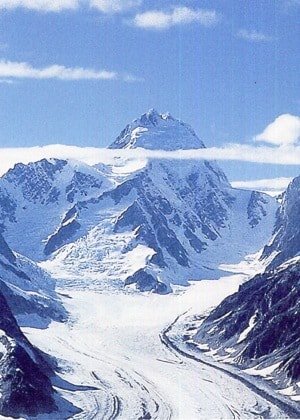The library system has a book The Unknown Mountain by Don Munday, published by Coyote Books, Lake Louise, 1993, which is a reprint of a 1948 book called Behind the Unknown Mountain.
Mount Waddington was named after Alfred Waddington who, in 1863 – 1864 tried to build a road from Bute Inlet along the Homathko River to the Barkerville gold fields. When First Nations people killed his crew, the project ended.
This is the story of the finding and exploring of Mt. Waddington by Don and Phyllis Munday, in the vast area between the Klina Kleene and Homathko Rivers, at the head of Knight and Bute Inlets, on the west coast of B.C. starting in 1926 and covering the next 11 years.
Their accomplishments as a couple are outstanding. Between 1920 and 1950 they climbed 100 major peaks in B.C. and Alberta, a third of these being first ascents – several were more than 11,000 feet (3,355m.)
It is interesting too that at the time, women were not mountain climbers and never appeared in anything less than a full skirt, but Phyllis was the first woman to scale Mount Robson. When they first reported their discovery, there was considerable disbelief and outright scoffing by the rest of the climbing fraternity.
The story describes the immense difficulties they faced when few roads existed, when grizzlies in numbers confronted them on the glaciers, when rampaging torrents created deadly quicksands or washed away the place they had formerly camped on or when avalanches rapidly eroded return routes.
They were among the first to use skis to come down crevass-ridden glaciers, an action the climbing fraternity ridiculed (for just a short time.)
It amazes me the difficulties they overcame and the severity of life on the glaciers.
Their mapping skills actually plotted the physical features so many could follow them and in fact, reached the final peak of Waddington (which the Mundays never did.)
Phyllis went to their mountain in later life (1950) by air with Sir Edmund Hillary and in 1983 a TV program “Thrill of a Lifetime” took her back (Beautiful B.C., spring 1983.)
In climbing many peaks, horses were needed to gain access and local ranchers packed for them. The picture of Harry and Muriel Haynes tying a diamond hitch is typical. (From Hoofprints in History, #1.)
A worthwhile read which makes me think of Mac Grady, who climbed in the Bowron Chain for years, one of the few who did that “way back when.”
Andy Motherwell is an amateur historian and regular Observer columnist.
